Epson EH-TW450 User Manual
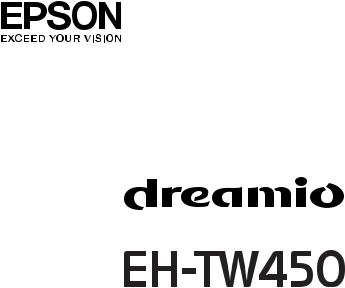
User's Guide

Notations Used in This Guide
•Safety indications
The documentation and the projector use graphical symbols to show how to use the projector safely.
The indications and their meaning are as follows. Make sure you understand them properly before reading the guide.
|
|
Warning |
This symbol indicates information that, if ignored, could possibly result in personal injury or even death due to incorrect handling. |
|
|
|
|
|
|
|
|
Caution |
This symbol indicates information that, if ignored, could possibly result in personal injury or physical damage due to incorrect handling. |
|
|
|
|
|
|
• General information indications |
|
|||
|
|
|
|
|
|
|
Attention |
Indicates procedures which may result in damage or injury if sufficient care is not taken. |
|
|
|
|
|
|
|
|
q |
Indicates additional information and points which may be useful to know regarding a topic. |
|
|
|
|
|
|
|
|
|
|
|
|
|
s |
Indicates a page where detailed information regarding a topic can be found. |
|
|
|
|
|
|
|
|
g |
Indicates that an explanation of the underlined word or words in front of this symbol appears in the glossary of terms. See the "Glossary" |
|
|
|
|
|
section of the "Appendix".s p.74 |
|
|
|
|
|
|
|
|
|
Indicates operating methods and the order of operations. |
|
|
Procedure |
|
|
|
|
|
|
The procedure indicated should be carried out in the order of the numbered steps. |
|
|
[ (Name) ] |
Indicates the name of the buttons on the Remote Control or the Control panel. |
|
|
|
|
|
Example: [Esc] button |
|
|
|
||
|
"(Menu Name)" |
Indicates Configuration Menu items. |
||
|
Brightness (bolded) |
Example: |
||
|
|
|
|
Select "Brightness" from the Image menu. |
|
|
|
|
Image menu - Brightness |
|
|
|
|
|

Contents |
|
3 |
|
|
|
Notations Used in This Guide.......................... |
2 |
Introduction
Part Names and Functions. . . . . . . . . . . . . . . . . . . . . . . . . . . . . . . . . . . . 6
Front/Top. . . . . . . . . . . . . . . . . . . . . . . . . . . . . . . . . . . . . . . . . . . . . . . . . . . . 6 Rear. . . . . . . . . . . . . . . . . . . . . . . . . . . . . . . . . . . . . . . . . . . . . . . . . . . . . . . . 7 Base. . . . . . . . . . . . . . . . . . . . . . . . . . . . . . . . . . . . . . . . . . . . . . . . . . . . . . . . 8 Control Panel. . . . . . . . . . . . . . . . . . . . . . . . . . . . . . . . . . . . . . . . . . . . . . . . . . 8 Remote Control. . . . . . . . . . . . . . . . . . . . . . . . . . . . . . . . . . . . . . . . . . . . . . . . 9 Connecting to Video Equipment. . . . . . . . . . . . . . . . . . . . . . . . . . . . . . . . . . . . 11
Useful Functions
Changing the Projected Image. . . . . . . . . . . . . . . . . . . . . . . . . . . . . . . 13
Automatically Detect Input Signal and Change the Projected Image (Source Search)
. . . . . . . . . . . . . . . . . . . . . . . . . . . . . . . . . . . . . . . . . . . . . . . . . . . . . . . . . . 13 Switch to the target image by Remote Control. . . . . . . . . . . . . . . . . . . . . . . . . . 14
Functions for Enhancing Projection. . . . . . . . . . . . . . . . . . . . . . . . . . 15
Selecting the Projection Quality (Selecting Color Mode). . . . . . . . . . . . . . . . . . . . 15 Setting the Auto Iris. . . . . . . . . . . . . . . . . . . . . . . . . . . . . . . . . . . . . . . . . . . . . 16 Hiding the Image and Sound Temporarily (A/V Mute). . . . . . . . . . . . . . . . . . . . . . 16 Freezing the Image (Freeze). . . . . . . . . . . . . . . . . . . . . . . . . . . . . . . . . . . . . . . 17 Changing the Aspect Ratio. . . . . . . . . . . . . . . . . . . . . . . . . . . . . . . . . . . . . . . . 17
Changing methods. . . . . . . . . . . . . . . . . . . . . . . . . . . . . . . . . . . . . . . . . . . 17 Changing the Aspect for video equipment images. . . . . . . . . . . . . . . . . . . . . . 18 Changing the aspect for computer images. . . . . . . . . . . . . . . . . . . . . . . . . . . 19
Security Functions. . . . . . . . . . . . . . . . . . . . . . . . . . . . . . . . . . . . . . . . . . 21
Restricting Operation (Control Panel Lock). . . . . . . . . . . . . . . . . . . . . . . . . . . . . 21
Anti-Theft Lock. . . . . . . . . . . . . . . . . . . . . . . . . . . . . . . . . . . . . . . . . . . . . . . . 22
Installing the wire lock. . . . . . . . . . . . . . . . . . . . . . . . . . . . . . . . . . . . . . . . . 22
Projecting JPEG Images in a Slideshow. . . . . . . . . . . . . . . . . . . . . . . 23
Specifications of Files that can be Projected in a Slideshow. . . . . . . . . . . . . . . . . . 23
Connecting and Removing USB Devices. . . . . . . . . . . . . . . . . . . . . . . . . . . . . . . 23 Connecting USB devices. . . . . . . . . . . . . . . . . . . . . . . . . . . . . . . . . . . . . . . . 23 Removing USB devices. . . . . . . . . . . . . . . . . . . . . . . . . . . . . . . . . . . . . . . . . 24 Starting and Ending a Slideshow. . . . . . . . . . . . . . . . . . . . . . . . . . . . . . . . . . . . 24 Starting a slideshow. . . . . . . . . . . . . . . . . . . . . . . . . . . . . . . . . . . . . . . . . . 24 Ending a slideshow. . . . . . . . . . . . . . . . . . . . . . . . . . . . . . . . . . . . . . . . . . . 24 Slideshow Basic Operations. . . . . . . . . . . . . . . . . . . . . . . . . . . . . . . . . . . . . . . 24 Rotating Images. . . . . . . . . . . . . . . . . . . . . . . . . . . . . . . . . . . . . . . . . . . . . . . 25 Projecting Image Files. . . . . . . . . . . . . . . . . . . . . . . . . . . . . . . . . . . . . . . . . . . 26 Projecting an image. . . . . . . . . . . . . . . . . . . . . . . . . . . . . . . . . . . . . . . . . . 26 Sequentially projecting all image files in a folder (Slideshow). . . . . . . . . . . . . . . 27 Image File Display Setting and Slideshow Operation Setting. . . . . . . . . . . . . . . . . 28
Configuration Menu
Using the Configuration Menu. . . . . . . . . . . . . . . . . . . . . . . . . . . . . . . 30
List of Functions. . . . . . . . . . . . . . . . . . . . . . . . . . . . . . . . . . . . . . . . . . . . 31
Image Menu. . . . . . . . . . . . . . . . . . . . . . . . . . . . . . . . . . . . . . . . . . . . . . . . . . 31
Signal Menu. . . . . . . . . . . . . . . . . . . . . . . . . . . . . . . . . . . . . . . . . . . . . . . . . . 32
Settings Menu. . . . . . . . . . . . . . . . . . . . . . . . . . . . . . . . . . . . . . . . . . . . . . . . 33
Extended Menu. . . . . . . . . . . . . . . . . . . . . . . . . . . . . . . . . . . . . . . . . . . . . . . 35
Info Menu (Display Only). . . . . . . . . . . . . . . . . . . . . . . . . . . . . . . . . . . . . . . . . 37
Reset Menu. . . . . . . . . . . . . . . . . . . . . . . . . . . . . . . . . . . . . . . . . . . . . . . . . . 38
Troubleshooting
Using the Help. . . . . . . . . . . . . . . . . . . . . . . . . . . . . . . . . . . . . . . . . . . . . . 40
Problem Solving. . . . . . . . . . . . . . . . . . . . . . . . . . . . . . . . . . . . . . . . . . . . 41
Reading the Indicators. . . . . . . . . . . . . . . . . . . . . . . . . . . . . . . . . . . . . . . . . . . 41 tIndicator is lit or flashing red. . . . . . . . . . . . . . . . . . . . . . . . . . . . . . . . . . . 42 moIndicator is lit or flashing orange. . . . . . . . . . . . . . . . . . . . . . . . . . . . . . 43 When the Indicators Provide No Help. . . . . . . . . . . . . . . . . . . . . . . . . . . . . . . . . 44 Problems relating to images. . . . . . . . . . . . . . . . . . . . . . . . . . . . . . . . . . . . . 45 Problems when projection starts. . . . . . . . . . . . . . . . . . . . . . . . . . . . . . . . . . 49

Contents |
|
4 |
|
|
|
Other problems. . . . . . . . . . . . . . . . . . . . . . . . . . . . . . . . . . . . . . . . . . . . . 49
Appendix
Installation Methods. . . . . . . . . . . . . . . . . . . . . . . . . . . . . . . . . . . . . . . . 52
Cleaning. . . . . . . . . . . . . . . . . . . . . . . . . . . . . . . . . . . . . . . . . . . . . . . . . . . 53
Cleaning the Projector's Surface. . . . . . . . . . . . . . . . . . . . . . . . . . . . . . . . . . . . 53
Cleaning the Lens. . . . . . . . . . . . . . . . . . . . . . . . . . . . . . . . . . . . . . . . . . . . . . 53
Cleaning the Air Filter. . . . . . . . . . . . . . . . . . . . . . . . . . . . . . . . . . . . . . . . . . . 54
Replacing Consumables. . . . . . . . . . . . . . . . . . . . . . . . . . . . . . . . . . . . . 55
Replacing the Remote Control Batteries. . . . . . . . . . . . . . . . . . . . . . . . . . . . . . . 55 Replacing the Lamp. . . . . . . . . . . . . . . . . . . . . . . . . . . . . . . . . . . . . . . . . . . . . 56 Lamp replacement period. . . . . . . . . . . . . . . . . . . . . . . . . . . . . . . . . . . . . . 56 How to replace the lamp. . . . . . . . . . . . . . . . . . . . . . . . . . . . . . . . . . . . . . . 56 Resetting the lamp hours. . . . . . . . . . . . . . . . . . . . . . . . . . . . . . . . . . . . . . . 59 Replacing the Air Filter. . . . . . . . . . . . . . . . . . . . . . . . . . . . . . . . . . . . . . . . . . . 59 Air filter replacement period. . . . . . . . . . . . . . . . . . . . . . . . . . . . . . . . . . . . . 59 How to replace the air filter. . . . . . . . . . . . . . . . . . . . . . . . . . . . . . . . . . . . . . 59
Optional Accessories and Consumables. . . . . . . . . . . . . . . . . . . . . . . 61
Optional accessories. . . . . . . . . . . . . . . . . . . . . . . . . . . . . . . . . . . . . . . . . . . . 61 Consumables. . . . . . . . . . . . . . . . . . . . . . . . . . . . . . . . . . . . . . . . . . . . . . . . . 61
Saving a User's Logo. . . . . . . . . . . . . . . . . . . . . . . . . . . . . . . . . . . . . . . . 62
Screen Size and Projection Distance. . . . . . . . . . . . . . . . . . . . . . . . . . 64
Monitoring and Controlling the Projector Using a Computer
(ESC/VP21 Commands). . . . . . . . . . . . . . . . . . . . . . . . . . . . . . . . . . . . . . 66
Before You Begin. . . . . . . . . . . . . . . . . . . . . . . . . . . . . . . . . . . . . . . . . . . . . . 66
Command List. . . . . . . . . . . . . . . . . . . . . . . . . . . . . . . . . . . . . . . . . . . . . . . . 66
Communications protocol. . . . . . . . . . . . . . . . . . . . . . . . . . . . . . . . . . . . . . 66
Supported Monitor Displays. . . . . . . . . . . . . . . . . . . . . . . . . . . . . . . . . 67
Component video. . . . . . . . . . . . . . . . . . . . . . . . . . . . . . . . . . . . . . . . . . . . 68 Composite video/S-video. . . . . . . . . . . . . . . . . . . . . . . . . . . . . . . . . . . . . . . 68 Input signal from the HDMI input port. . . . . . . . . . . . . . . . . . . . . . . . . . . . . . 69
Specifications. . . . . . . . . . . . . . . . . . . . . . . . . . . . . . . . . . . . . . . . . . . . . . 70
Projector General Specifications. . . . . . . . . . . . . . . . . . . . . . . . . . . . . . . . . . . . 70
Appearance. . . . . . . . . . . . . . . . . . . . . . . . . . . . . . . . . . . . . . . . . . . . . . . . 73
Glossary. . . . . . . . . . . . . . . . . . . . . . . . . . . . . . . . . . . . . . . . . . . . . . . . . . . 74
General Notes. . . . . . . . . . . . . . . . . . . . . . . . . . . . . . . . . . . . . . . . . . . . . . 76
General Notice:. . . . . . . . . . . . . . . . . . . . . . . . . . . . . . . . . . . . . . . . . . . . . . . . 76
Index. . . . . . . . . . . . . . . . . . . . . . . . . . . . . . . . . . . . . . . . . . . . . . . . . . . . . . 77
Supported Monitor Displays. . . . . . . . . . . . . . . . . . . . . . . . . . . . . . . . . . . . . . . 67
Computer signals (analog RGB). . . . . . . . . . . . . . . . . . . . . . . . . . . . . . . . . . . 67

Introduction
This chapter explains the part names and connection with video equipment.

Part Names and Functions |
|
6 |
|
|
|
Front/Top
Name |
Function |
A Lamp cover |
Open this cover when replacing the projector's Lamp. |
|
s p.56 |
|
|
B Air exhaust vent |
Exhaust vent for air used to cool the projector internally. |
 Caution
Caution
Do not place objects that may become warped or otherwise affected by heat near the Air exhaust vent and do not put your face or hands near the vent while projection is in progress.
|
Name |
Function |
C |
A/V mute slide knob |
Slide the knob to open and close the A/V mute slide. |
|
|
|
D |
A/V mute slide |
Close when not using the projector to protect the lens. |
|
|
By closing during projection you can hide the image and |
|
|
the sound (A/V Mute).s p.16 |
|
|
|
E |
Foot adjust lever |
Pull the Foot adjust lever to extend and retract the Front |
|
|
adjustable foot.s Quick Start Guide |
|
|
|
F |
Front adjustable foot |
Extend and adjust the position of the projected image |
|
|
when the projector is placed on a surface such as a desk. |
|
|
s Quick Start Guide |
G |
Remote Receiver |
Receives signals from the remote control.s Quick Start |
|
|
Guide |
H |
Air filter |
Takes in air to cool the projector internally. If dust |
|
(Air intake vent) |
collects here it can cause the internal temperature to |
|
|
rise, and this can lead to problems with operation and |
|
|
shorten the optical engine's service life. Be sure to clean |
|
|
the Air filter regularly. s p.54, p.59 |
|
|
|
I |
Air filter cover |
Open and close when replacing the air filter.s p.59 |
|
|
|
J |
Speaker |
|
|
|
|
K |
Security slot |
The Security slot is compatible with the Microsaver |
|
|
Security System manufactured by Kensington.s p.22 |
|
|
|
L |
Zoom ring |
Adjusts the image size.s Quick Start Guide |
|
|
|
M |
Focus ring |
Adjusts the image focus.s Quick Start Guide |
|
|
|
N |
Control panel |
s p.8 |
|
|
|
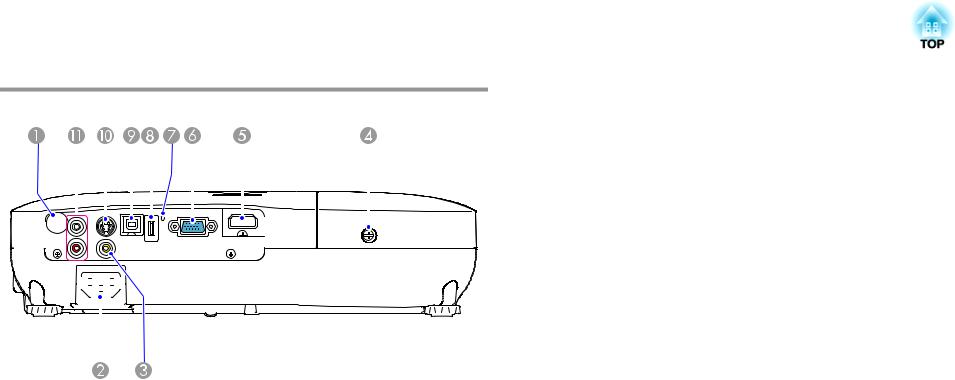
Part Names and Functions |
|
7 |
|
|
|
Rear
|
|
|
|
|
|
|
|
|
|
|
|
|
|
|
|
|
|
|
|
|
|
|
|
|
|
|
|
|
|
|
|
|
|
|
|
|
|
|
|
|
|
|
|
|
|
|
|
|
|
|
|
|
|
|
|
|
|
|
|
|
|
|
|
|
|
|
|
|
|
|
|
|
|
|
|
|
|
|
|
|
|
|
|
|
|
|
|
|
|
|
|
|
|
|
|
|
|
|
|
|
|
|
|
|
|
|
|
|
|
|
|
|
|
|
|
|
|
|
|
|
|
|
|
|
|
|
|
|
|
|
|
|
|
|
|
|
|
|
|
|
|
|
|
|
|
|
|
|
|
|
|
|
|
|
|
|
|
|
|
|
|
|
|
|
|
|
|
|
|
|
|
|
|
|
|
|
|
|
|
|
|
|
|
|
|
|
|
|
|
|
|
|
|
|
|
|
|
|
|
|
|
|
|
|
|
|
|
|
|
|
|
|
|
|
|
|
|
|
|
|
|
|
|
|
|
|
|
|
|
|
|
|
|
|
|
|
|
|
|
|
|
|
|
|
|
|
|
|
|
|
|
|
|
|
|
|
|
|
|
|
|
|
|
|
|
|
|
|
|
|
|
|
|
|
|
|
|
|
|
|
|
|
|
|
|
|
|
|
|
|
|
|
|
|
|
|
|
|
|
|
|
|
|
|
|
|
|
|
|
|
|
|
|
|
|
|
|
|
|
|
|
|
|
|
|
|
|
|
|
|
|
|
|
|
|
|
|
|
|
|
|
|
|
|
|
|
|
|
|
|
|
|
|
|
|
|
|
|
|
|
|
|
|
|
|
|
|
|
|
|
|
|
|
|
|
|
|
|
|
|
|
|
|
|
|
|
|
|
|
|
|
|
|
|
|
|
|
|
|
|
|
|
|
|
|
|
|
|
|
|
|
|
|
|
|
|
|
|
|
|
|
|
|
|
|
|
|
|
|
|
|
|
|
|
|
|
|
|
|
|
|
|
|
|
|
|
|
|
|
|
|
|
|
|
|
|
|
|
|
|
|
|
|
|
|
|
|
|
|
|
|
|
|
|
|
|
|
|
|
|
|
|
|
|
|
|
|
|
|
|
|
|
|
|
|
|
|
|
|
|
|
|
|
|
|
|
|
|
|
|
|
|
|
|
|
|
|
|
|
|
|
|
|
|
|
|
|
|
|
|
|
|
|
|
|
|
|
|
|
|
|
|
|
|
|
|
|
|
|
|
|
|
|
|
|
|
|
|
|
|
|
|
|
|
|
|
|
|
|
|
|
|
|
|
|
|
|
|
|
|
|
|
|
|
|
|
|
|
|
|
|
|
|
|
|
|
|
|
|
|
|
|
|
|
|
|
|
|
|
Name |
|
|
|
|
|
|
Function |
||||||||||||||||||||||
A |
|
Remote Receiver |
|
Receives signals from the remote control.s Quick Start |
|||||||||||||||||||||||||||||||||||
|
|
|
|
|
|
|
|
|
|
|
|
|
|
|
|
|
|
|
|
|
|
|
|
|
|
|
Guide |
||||||||||||
|
|
|
|
|
|
|
|
|
|
|
|
|
|
|
|
|
|
|
|
|
|
|
|
|
|
|
|
|
|
|
|
|
|||||||
B |
|
Power inlet |
|
Connects to the power cable.s Quick Start Guide |
|||||||||||||||||||||||||||||||||||
|
|
|
|
|
|
|
|
|
|
|
|
|
|
|
|
|
|
|
|
|
|
|
|
|
|
|
|
|
|
|
|
|
|||||||
C |
|
Video Input Port |
|
For composite video signals from video sources. |
|||||||||||||||||||||||||||||||||||
|
|
|
|
|
|
|
|
|
|
|
|
|
|
|
|
|
|
|
|
|
|
|
|
|
|
|
|
|
|
|
|
|
|||||||
D |
|
Lamp Cover Fixing |
|
Screw to fix the Lamp cover in place.s p.56 |
|||||||||||||||||||||||||||||||||||
|
|
|
Screw |
|
|
|
|
|
|
|
|
|
|
|
|
|
|
||||||||||||||||||||||
|
|
|
|
|
|
|
|
|
|
|
|
|
|
|
|
|
|
|
|
|
|
|
|
|
|
|
|
|
|
|
|
|
|||||||
E |
|
HDMI input port |
|
Inputs video signals from HDMI compatible video |
|||||||||||||||||||||||||||||||||||
|
|
|
|
|
|
|
|
|
|
|
|
|
|
|
|
|
|
|
|
|
|
|
|
|
|
|
equipment and computers. This projector is compatible |
||||||||||||
|
|
|
|
|
|
|
|
|
|
|
|
|
|
|
|
|
|
|
|
|
|
|
|
|
|
|
with HDCPg. |
||||||||||||
|
|
|
|
|
|
|
|
|
|
|
|
|
|
|
|
|
|
|
|
|
|
|
|
|
|
|
|
|
|
|
|
|
|||||||
F |
|
Computer input port |
|
For video signals from a computer and component |
|||||||||||||||||||||||||||||||||||
|
|
|
|
|
|
|
|
|
|
|
|
|
|
|
|
|
|
|
|
|
|
|
|
|
|
|
video signals from other video sources. |
||||||||||||
|
|
|
|
|
|
|
|
|
|
|
|
|
|
|
|
|
|
|
|
|
|
|
|
|
|
|
|
|
|
|
|
|
|
|
|
|
|
|
|
|
Name |
Function |
G |
USB indicator |
The following explains the status of USB devices |
|
|
connected to USB(TypeA) port. |
|
|
OFF: USB device is not connected |
|
|
Orange Light ON: USB device is connected |
|
|
Green Light ON: USB device is operating |
|
|
Red Light ON: Error |
|
|
|
H |
USB(TypeA) port |
Connects a USB storage device or a digital camera, and |
|
|
projects JPEG images using Slideshow. |
|
|
|
I |
USB(TypeB) port |
When controlling the projector from a computer, |
|
|
connect it to the computer with a commercially |
|
|
available USB cable. This port is for control use and |
|
|
should not normally be used.s p.66 |
|
|
|
J |
S-Video input port |
For S-video signals from video sources. |
|
|
|
K |
Audio-L/R port |
Inputs audio from the audio out port on the other |
|
|
equipment.s Quick Start Guide |
|
|
|
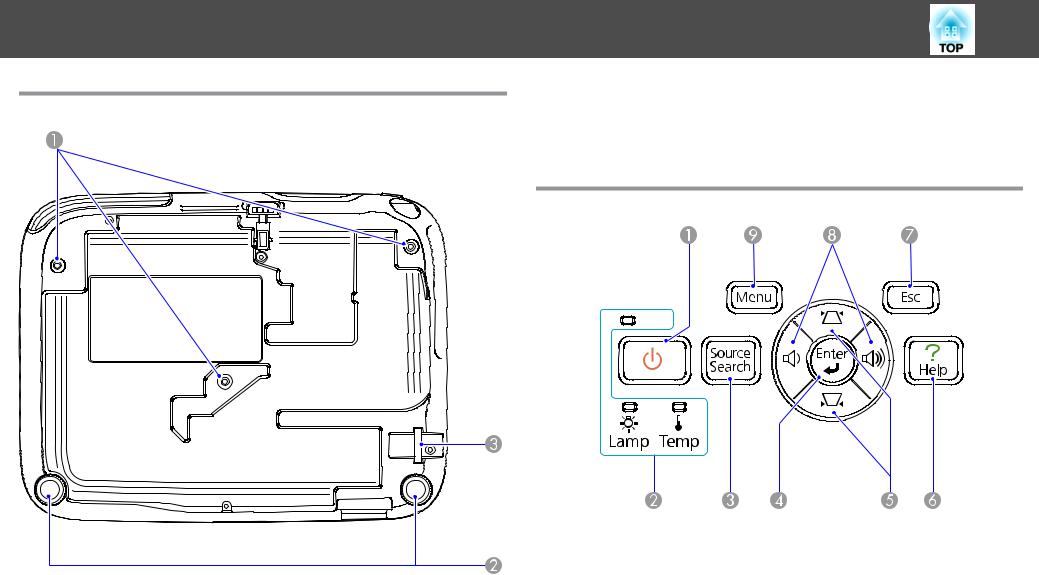
Part Names and Functions
Base
|
Name |
Function |
A |
Ceiling mount fixing |
Attach the optional Ceiling mount here when |
|
points |
suspending the projector from a ceiling. s p.52, |
|
(three points) |
p.61 |
|
|
|
B |
Rear foot |
When setup on a desk, turn to extend and retract to |
|
|
adjust the horizontal tilt.s Quick Start Guide |
|
|
|
8
|
Name |
Function |
C |
Security cable |
Pass a commercially available wire lock through here |
|
installation point |
and lock it in place. s p.22 |
|
|
|
Control Panel
|
Name |
Function |
A |
[t] button |
Turns the projector power on or off.sQuick Start Guide |
|
|
|
B |
Status indicators |
The color of the indicators and whether they are flashing |
|
|
or lit indicate the status of the projector. s p.41 |
|
|
|
C |
[Source Search] |
Changes to the next input source that is connected to |
|
button |
the projector and is sending an image.s p.13 |
|
|
|

Part Names and Functions |
|
9 |
|
|
|
|
Name |
|
|
Function |
|
|
|
|
|
|
|
|
|
|
|
|
|
|
|
|
|
Remote Control |
|||||||||||||||
D |
[Enter] button |
If pressed during projection of computer signal images, |
||||||||||||||||
|
|
|
|
|
|
|
|
|
|
|
|
|
||||||
|
|
it automatically adjusts the Tracking, Sync., and |
|
|
|
|
|
|
|
|
|
|
|
|
|
|||
|
|
Position to project the optimum image. When a |
|
|
|
|
|
|
|
|
|
|
|
|
|
|||
|
|
Configuration Menu or a Help screen is displayed, it |
|
|
|
|
|
|
|
|
|
|
|
|
|
|||
|
|
accepts and enters the current selection and moves to |
|
|
|
|
|
|
|
|
|
|
|
|
|
|||
|
|
the next level. |
|
|
|
|
|
|
|
|
|
|
|
|
|
|
|
|
|
|
|
|
|
|
|
|
|
|
|
|
|
|
|
|
|||
E |
[w][v] buttons |
Corrects Keystone distortion. s Quick Start Guide |
|
|
|
|
|
|
|
|
|
|
|
|
|
|||
|
|
However, when projecting in Slideshow, the buttons |
|
|
|
|
|
|
|
|
|
|
|
|
|
|||
|
|
|
|
|
|
|
|
|
|
|
|
|
|
|
||||
|
|
only have the [ |
][ |
] functions. If pressed when a |
|
|
|
|
|
|
|
|
|
|
|
|
|
|
|
|
Configuration Menu or a Help screen is displayed, these |
|
|
|
|
|
|
|
|
|
|
|
|
|
|||
|
|
buttons select menu items and setting values.s p.30 |
|
|
|
|
|
|
|
|
|
|
|
|
|
|||
|
|
|
|
|
|
|
|
|
|
|
|
|
|
|
|
|||
F |
[Help] button |
Displays and closes the Help screen which shows you |
|
|
|
|
|
|
|
|
|
|
|
|
|
|||
|
|
how to deal with problems if they occur.s p.40 |
|
|
|
|
|
|
|
|
|
|
|
|
|
|||
|
|
|
|
|
|
|
|
|
|
|
|
|
|
|
||||
G |
[Esc] button |
Stops the current function. If pressed when a |
|
|
|
|
|
|
|
|
|
|
|
|
|
|||
|
|
|
|
|
|
|
|
|
|
|
|
|
||||||
|
|
Configuration menu is displayed, it moves to the |
|
|
|
|
|
|
|
|
|
|
|
|
|
|||
|
|
|
|
|
|
|
|
|
|
|
|
|
|
|
||||
|
|
previous menu level. sp.30 |
|
|
|
|
|
|
|
|
|
|
|
|
|
|||
|
|
|
|
|
|
|
|
|
|
|
|
|
|
|
|
|
|
|
H |
[a][b] buttons |
Adjusts the volume. s Quick Start Guide |
|
|
|
|
|
|
|
|
|
|
|
|
|
|||
|
|
However, when projecting in Slideshow, the buttons |
|
|
|
|
|
|
|
|
|
|
|
|
|
|||
|
|
only have the [ |
][ |
] functions. If pressed when a |
|
|
|
|
|
|
|
|
|
|
|
|
|
|
|
|
Configuration Menu or a Help screen is displayed, these |
|
|
|
|
|
|
|
|
|
|
|
|
|
|||
|
|
buttons select menu items and setting values.s p.30 |
|
|
|
|
|
|
|
|
|
|
|
|
|
|||
|
|
|
|
|
|
|
|
|
|
|
|
|
|
|
|
|
|
|
I |
[Menu] button |
Displays and closes the Configuration Menu.s p.30 |
|
|
|
|
|
|
|
|
|
|
|
|
|
|||
|
|
|
|
|
|
|
|
|
|
|
|
|
|
|
|
|
|
|
|
|
|
|
|
|
|
|
|
|
|
|
|
|
|
|
|
|
|

Part Names and Functions |
|
10 |
|
|
|
|
|
Name |
|
Function |
A |
[t] button |
|
Turns the projector power On or Off.s Quick Start |
|
|
|
|
|
Guide |
|
|
|
||
B |
[Computer] button |
Changes to images from the Computer input port. |
||
|
|
|
|
s p.14 |
|
|
|
|
|
C |
[Video] button |
|
Each time the button is pressed, the image cycles |
|
|
|
|
|
through Video, S-Video, and HDMI input ports. |
|
|
|
|
s p.14 |
|
|
|
|
|
D |
[USB] button |
|
Changes to the Slideshow image.s p.14 |
|
|
|
|
||
E |
[A/V Mute] button |
Turns the video and audio on or off.s p.16 |
||
|
|
|
|
|
F |
[Aspect] button |
|
The Aspect Ratio changes each time the button is pressed. |
|
|
|
|
|
s p.17 |
|
|
|
|
|
G |
[Auto] button |
|
If pressed during projection of computer signal images, |
|
|
|
|
|
it automatically adjusts the Tracking, Sync., and |
|
|
|
|
Position to project the optimum image. |
|
|
|
|
|
H |
[Menu] button |
|
Displays and closes the Configuration Menu.s p.30 |
|
|
|
|
|
|
I |
[ |
][ |
] |
When a Configuration Menu or Help screen is |
|
[ ][ |
] button |
|
displayed, it selects menu items and setting values. |
|
|
s p.30 |
||
|
|
|
|
|
|
|
|
|
|
J |
[Enter] button |
|
When a Configuration Menu or a Help screen is |
|
|
|
|
|
displayed, it accepts and enters the current selection and |
|
|
|
|
moves to the next level. s p.30 |
|
|
|
|
|
K |
[Esc] button |
|
Stops the current function. If pressed when a |
|
|
|
|
|
configuration menu is displayed, it moves to the |
|
|
|
|
previous level. s p.30 |
|
|
|
||
L |
[Volume] buttons (a) |
(a) Decreases the Volume. |
||
|
(b) |
|
|
(b) Increases the Volume. |
|
|
|
|
s Quick Start Guide |
|
|
|
|
|
M |
[Help] button |
|
Displays and closes the Help screen which shows you |
|
|
|
|
|
how to deal with problems if they occur.s p.40 |
N |
[Color Mode] button |
Each time the button is pressed, the Color Mode changes. |
||
|
|
|
|
s p.15 |
|
|
|
|
|
|
Name |
Function |
O |
[User] button |
Press to assign a frequently used item from the four |
|
|
available Configuration Menu items. By pressing the |
|
|
button the assigned menu item selection/adjustment |
|
|
screen is displayed, allowing you to make one-touch |
|
|
settings/adjustments. Power Consumption is assigned |
|
|
as the default setting.s p.33 |
|
|
|
P |
[Freeze] button |
Images are paused or unpaused.s p.17 |
|
|
|
Q |
[Search] button |
Changes to the next input source that is connected to |
|
|
the projector and is sending an image.s p.13 |
|
|
|
R |
Remote control |
Outputs remote control signals. |
|
light-emitting area |
|
|
|
|
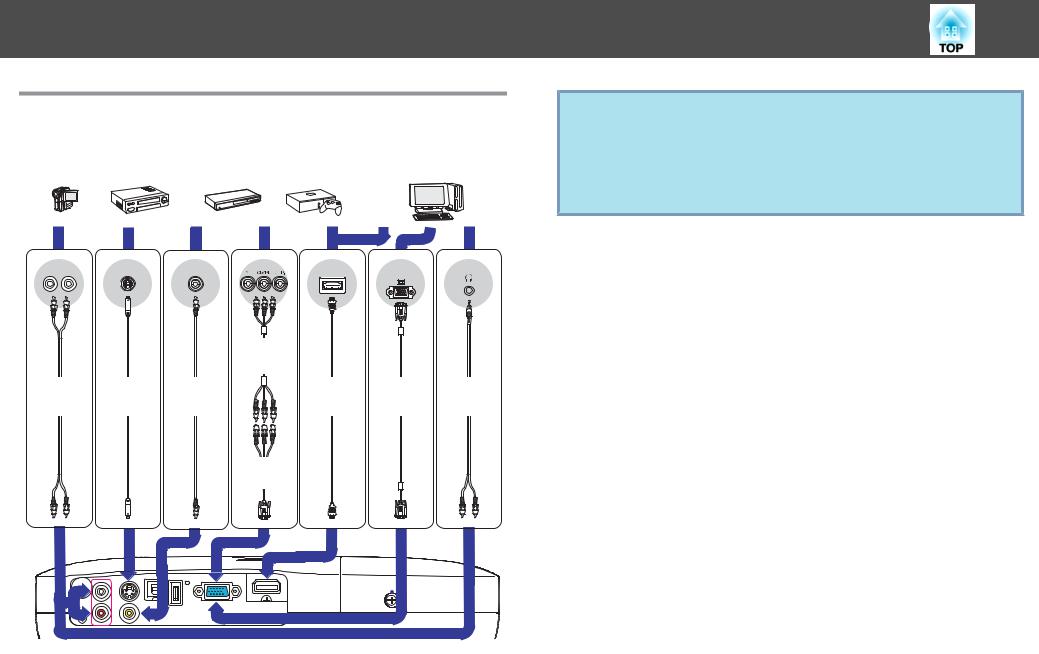
Part Names and Functions
Connecting to Video Equipment
Port names may vary depending on the equipment being connected.
Video equipment (VHS VCR, DVD player, game console, etc.) |
|
Computer |
|
|
|
|
|
|
|
|
|
|
|
|
|
|
|
|
Component |
|
Mini D-Sub |
|
|
L-Audio-R |
S-Video |
Video |
output |
HDMI |
Audio |
||
15-pin |
|||||||
|
Component video cable (commercially -available)
Audio cable |
S-Video cable |
RCA video |
HDMI cable |
Computer |
Audio cable |
|
cable |
||||||
(commercially- (commercially- |
(commercially- |
cable |
(commercially- |
|||
(commercially |
||||||
available) |
available) |
-available) |
available) |
(optionnal) |
available) |
|
|
|
|
|
|
||
component adapter (accessory)
11
Attention
•Power off the equipment before connecting. Connecting while it is powered on may cause malfunctions to occur.
•When connecting, check the cable's connector shape with the shape of the port. Inserting a connector with a different orientation or shape by force may cause malfunctions to occur or may damage the equipment.
q |
• Use an HDMI cable that conforms to HDMI standard. |
• Depending on the equipment you are connecting to, the |
|
|
connecter shape may be specific to that equipment. In such a |
|
case, use the cable that was supplied with the equipment or is |
|
available as an optional accessory for that equipment. |
|
• The cable used to connect to the projector will vary according to |
|
the video signal output from the video equipment. Some video |
|
equipment can output several different types of video signals. In |
|
general, the following are video signals in the order of image |
|
quality, from best quality to lesser quality. |
|
Component video > S-video > Composite video |
|
Check your video equipment's documentation to see which video |
|
signals it can output. Composite video may also be simply called |
|
"Video out". |
|
|
For information on optional accessories, see s "Optional Accessories and Consumables" p.61.

Useful Functions
This chapter explains useful tips for projection, and the Security functions.
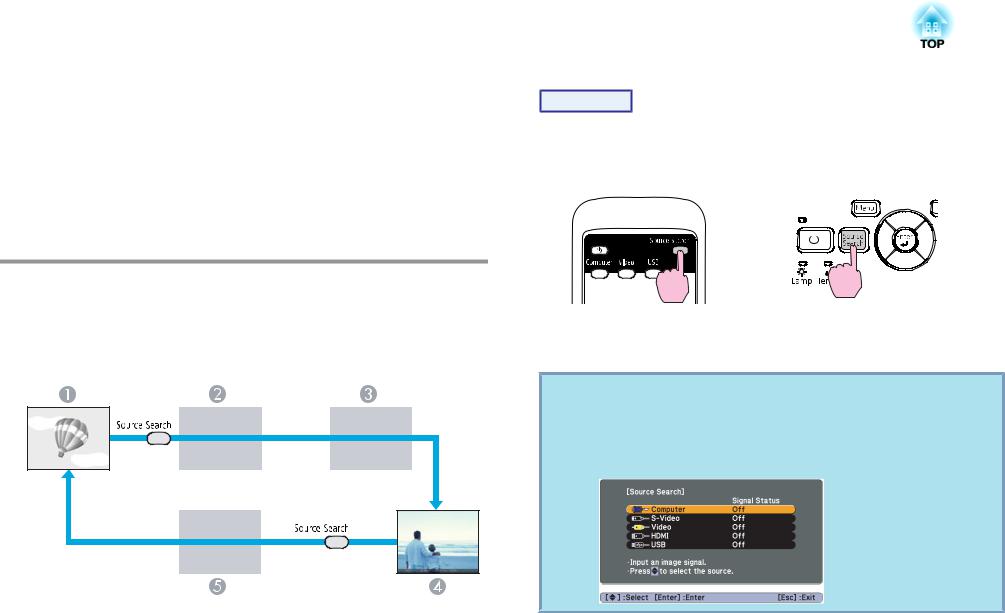
Changing the Projected Image |
|
13 |
|
|
|
You can change the projected image in the following two ways.
•Changing by Source Search
The projector automatically detects signals being input from connected equipment, and the image being input from the equipment is projected.
•Changing directly to the target image
You can use the Remote Control buttons to change to the target input port.
Automatically Detect Input Signal and Change the Projected Image (Source Search)
You can project the target image quickly as input ports with no image signal being input are ignored when you change by pressing the [Source Search] button.
AComputer
BS-Video
CVideo
DHDMI
EUSB
Procedure
When your video equipment is connected, start playback before beginning this operation.
Using the Remote Control |
Using the Control panel |
|||||
|
|
|
|
|
|
|
|
|
|
|
|
|
|
|
|
|
|
|
|
|
|
|
|
|
|
|
|
When two or more pieces of equipment are connected, press the [Source Search] button until the target image is projected.
q The following screen showing the status of image signals is displayed when only the image that the projector is currently displaying is available, or when no image signal can be found. You can select the input port where the equipment you want to use is connected. If no operation is performed after about 10 seconds, the screen closes.

Changing the Projected Image |
|
14 |
|
|
|
Switch to the target image by Remote Control
You can change directly to the target image by pressing the following buttons on the Remote Control.
Remote Control
AChanges to images from the Computer input port.
BEach time the button is pressed, the image cycles through Video, S-Video, and HDMI input ports.
CChanges to the Slideshow image.
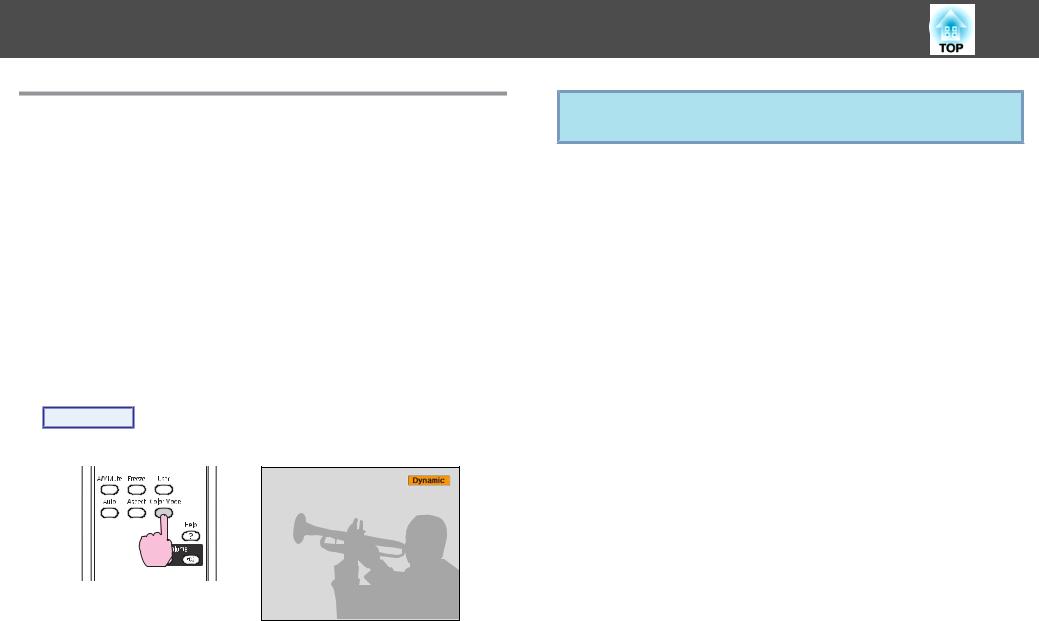
Functions for Enhancing Projection
Selecting the Projection Quality (Selecting Color
Mode)
You can easily obtain the optimum image quality simply by selecting the setting that best corresponds to your surroundings when projecting. The brightness of the image varies depending on the mode selected.
Mode |
Application |
Dynamic |
Ideal for use in a bright room. |
|
|
Living Room |
Ideal for using the projector in a room with closed |
|
curtains. |
|
|
Theatre |
Ideal for watching films in a dark room. Gives images |
|
a natural tone. |
|
|
Game |
Ideal for playing games that involve speed in a bright |
|
room. |
|
|
Procedure
Remote Control
15
q The color mode can also be set using Color Mode in the Image menu from the Configuration Menu.s p.31
Each time you press the button, the Color Mode name is displayed on the screen and the Color Mode changes.
If you press the button while the Color Mode name is displayed on the screen, it changes to the next Color Mode.
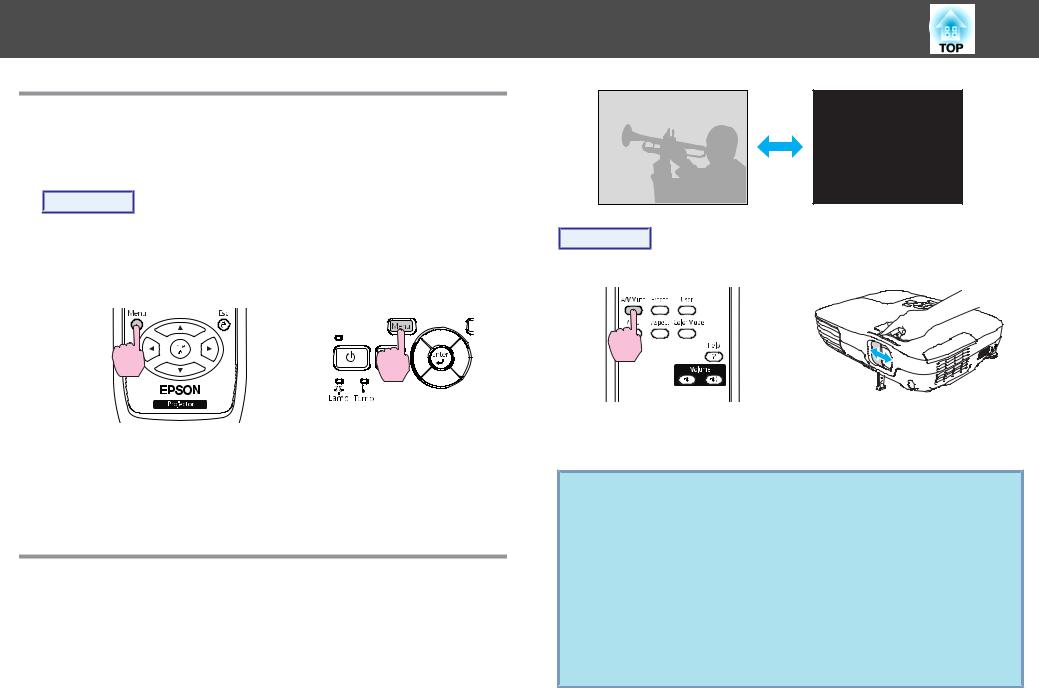
Functions for Enhancing Projection
Setting the Auto Iris
By automatically setting the luminance according to the brightness of the displayed image, it lets you enjoy deep and rich images.
Procedure
A Press the [Menu] button and select Image - Auto Iris from the Configuration Menu.s "Using the Configuration Menu" p.30
Using the Remote Control |
Using the Control panel |
16
Procedure
Remote Control |
Body |
B Select On.
The setting is stored for each Color Mode.
C Press the [Menu] button to close the Configuration Menu.
Hiding the Image and Sound Temporarily (A/V
Mute)
Use this to temporarily turn off the screen image.
Each time you press the button, or open/close the lens cover A/V Mute turns on or off.
q |
• If you use this function when projecting moving images, the |
|||
images and |
sound continue to be played back by |
the |
source, and |
|
|
you cannot |
return to the point where A/V Mute |
was |
activated. |
•When activated from the remote control, you can choose to display Black, Blue, or Logo as the A/V Mute display using the Extended - Display - A/V Mute setting from the Configuration menu.s p.35
•When the A/V mute slide is closed for approximately 30 minutes, Lens Cover Timer activates and the power is automatically turned off. If you do not want Lens Cover Timer to activate, change the Lens Cover Timer setting to Off from
Operation in the Extended menu.s p.35
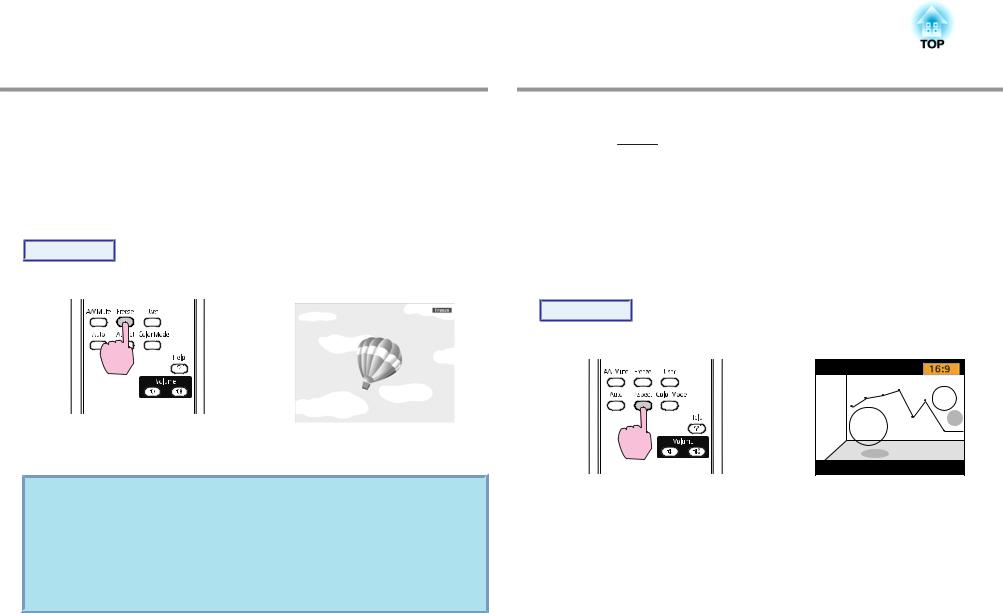
Functions for Enhancing Projection |
|
17 |
|
|
|
Freezing the Image (Freeze)
When Freeze is activated on moving images, the frozen image continues to project on the screen, so you can project a moving image one frame at a time like a still photo. Also, you can perform operations such as changing between files during presentations from a computer without projecting any images if the Freeze function is activated beforehand.
Procedure
Remote Control
Each time you press the button, Freeze turns on or off.
q |
• |
Audio does |
not stop. |
|
• The image |
source continues to play back |
the moving images |
||
|
|
even while the screen is frozen, and so it is not possible to |
||
|
|
resume projection from the point where |
it was paused. |
|
•If the [Freeze] button is pressed while the Configuration Menu or a Help screen is displayed, the menu or Help screen being displayed is cleared.
Changing the Aspect Ratio
Change the Aspect Ratiog when video equipment is connected so that images that have been recorded in digital video or onto DVDs can be viewed in 16:9 wide-screen format. Change the Aspect Ratio when projecting computer images at full size.
The changing methods and the types of Aspect ratio are as follows.
Changing methods
Procedure
Remote Control
Each time you press the button, the Aspect name is displayed on the screen and the Aspect changes.
If you press the button while the Aspect name is displayed on the screen, it changes to the next Aspect Mode.
The aspect ratio can also be set using |
Aspect in the Signal menu |
q from the Configuration Menu.s p.32 |
|
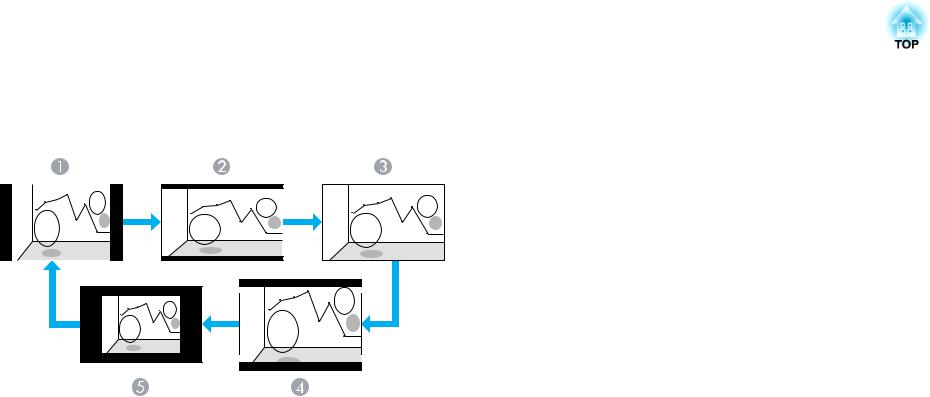
Functions for Enhancing Projection |
|
18 |
|
|
|
Changing the Aspect for video equipment images
Each time the button is pressed, it changes in the order Normal or
Auto, 16:9, Full, Zoom, and Native.
ANormal or Auto
B16:9
CFull
DZoom
ENative
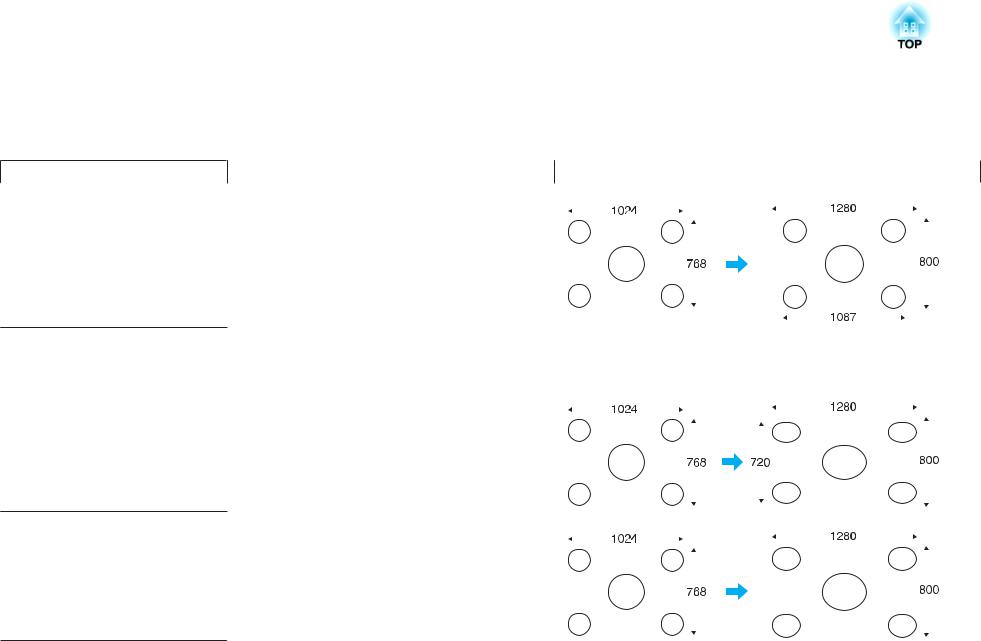
Functions for Enhancing Projection |
|
19 |
|
|
|
Changing the aspect for computer images
You can change the Aspect as follows. This projector offers WXGA 1280x800 resolution (Aspect Ratio 16:10). When projecting onto 16:9 screens, set the Aspect to 16:9.
Set Values |
Operation |
|
|
|
|
|
|
|
|
|
|
Projection example |
||||||||||||||
Normal |
Projects to the full projection size retaining the Aspect of |
When a 1024x768 signal is input |
||||||||||||||||||||||||
|
the input image. |
|
|
|
|
|
|
|
|
|
|
|
|
|
|
|
|
|
|
|
|
|
|
|
|
|
|
|
|
|
|
|
|
|
|
|
|
|
|
|
|
|
|
|
|
|
|
|
|
|
|
|
|
|
|
|
|
|
|
|
|
|
|
|
|
|
|
|
|
|
|
|
|
|
|
|
|
|
|
|
|
|
|
|
|
|
|
|
|
|
|
|
|
|
|
|
|
|
|
|
|
|
|
|
|
|
|
|
|
|
|
|
|
|
|
|
|
|
|
|
|
|
|
|
|
|
|
|
|
|
|
|
|
|
|
|
|
|
|
|
|
|
|
|
|
|
|
|
|
|
|
|
|
|
|
|
|
|
|
|
|
|
|
|
|
|
|
|
|
|
|
|
|
|
|
|
|
|
|
|
|
|
|
|
|
|
|
|
|
|
|
|
|
|
|
|
|
|
|
|
|
|
|
|
|
|
|
|
|
|
|
|
|
|
|
Auto |
Projects in an appropriate aspect based on information |
|
|
|
|
|
|
|
|
|
|
|
|
|
|
|
|
|
|
|
|
|
|
|
|
|
|
Displayed only when the source is |
from the input signal. |
|
|
|
|
|
|
|
|
|
|
|
|
|
|
|
|
|
|
|
|
|
|
|
|
|
|
HDMI. |
|
|
|
|
|
|
|
|
|
|
|
|
|
|
|
|
|
|
|
|
|
|
|
|
|
|
|
|
|
|
|
|
|
|
|
|
|
|
|
|
|||||||||||||||
16:9 |
Projects to the full projection size at an Aspect of 16:9. |
When a 1024x768 signal is input |
|
|
|
|
|
|
|
|
|
|
|||||||||||||||
|
|
|
|
|
|
|
|
|
|
|
|
|
|
|
|
|
|
|
|
|
|
|
|
|
|
|
|
|
|
|
|
|
|
|
|
|
|
|
|
|
|
|
|
|
|
|
|
|
|
|
|
|
|
|
|
|
|
|
|
|
|
|
|
|
|
|
|
|
|
|
|
|
|
|
|
|
|
|
|
|
|
|
|
|
|
|
|
|
|
|
|
|
|
|
|
|
|
|
|
|
|
|
|
|
|
|
|
|
|
|
|
|
|
|
|
|
|
|
|
|
|
|
|
|
|
|
|
|
|
|
|
|
|
|
|
|
|
|
|
|
|
|
|
|
|
|
|
|
|
|
|
|
|
|
|
|
|
|
|
|
|
|
|
|
|
|
|
|
|
|
|
|
|
|
|
|
|
|
|
|
|
|
|
|
|
|
|
|
|
|
|
|
|
|
|
Full |
Project at full size. |
When a 1024x768 signal is input |
|
|
|
|
|
|
|
||||||||||||
|
|
|
|
|
|
|
|
|
|
|
|
|
|
|
|
|
|
|
|
|
|
|
|
|
|
|
|
|
|
|
|
|
|
|
|
|
|
|
|
|
|
|
|
|
|
|
|
|
|
|
|
|
|
|
|
|
|
|
|
|
|
|
|
|
|
|
|
|
|
|
|
|
|
|
|
|
|
|
|
|
|
|
|
|
|
|
|
|
|
|
|
|
|
|
|
|
|
|
|
|
|
|
|
|
|
|
|
|
|
|
|
|
|
|
|
|
|
|
|
|
|
|
|
|
|
|
|
|
|
|
|
|
|
|
|
|
|
|
|
|
|
|
|
|
|
|
|
|
|
|
|
|
|
|
|
|
|
|
|
|
|
|
|
|
|
|
|
|
|
|
|
|
|
|
|

Functions for Enhancing Projection |
|
20 |
|
Set Values |
Operation |
Projection example |
|
Zoom |
Projects the input image at the lateral direction aspect size |
When a 1024x768 signal is input |
|
|
as it is. Parts that extend beyond the projection size are not |
|
|
|
projected. |
|
|
Native |
Projects at the resolution of the input image size to the |
When an 800x600 signal is input |
When an 1400x1050 signal is input |
|
center of the screen. This is ideal for projecting clear images. |
|
|
|
If the image resolution exceeds 1280x800, the edges of the |
|
|
|
image are not projected. |
|
|
q If parts of the image are missing, set Wide or Normal in Resolution from the Configuration Menu depending on the size of the computer panel. s p.32

Security Functions |
21 |
The projector has the following enhanced security functions.
•Control Panel Lock
You can prevent people changing the settings on the projector without permission.s p.21
•Anti-Theft Lock
The projector is equipped with various types of anti-theft security devices. s p.22
Restricting Operation (Control Panel Lock)
Perform one of the following to lock the operation buttons on the Control panel.
The projector can still be operated using the Remote Control.
•Full Lock
All of the buttons on the Control panel are locked. You cannot perform any operations from the Control panel, including turning the power on or off.
•Partial Lock
All of the buttons on the Control panel, except for the [t] button, are locked.
Procedure
A During projection, press the [Menu] button and select
Settings - Control Panel Lock from the Configuration Menu. s "Using the Configuration Menu" p.30
Using the Remote Control |
Using the Control panel |
B Select either Full Lock or Partial Lock.
C Select Yes when the confirmation message is displayed.
The Control panel buttons are locked according to the setting you chose.

Security Functions |
|
22 |
|
|
|
q You can release the Control panel lock by one of the following two methods.
•From the Remote Control, select Off in Settings - Control Panel Lock from the Configuration Menu.
•Press and hold down the [Enter] button on the Control panel for about seven seconds, a message is displayed and the lock is released.
Anti-Theft Lock
As the projector is often setup on ceiling mounts and left in rooms unattended, the projector includes the following security devices to prevent someone from taking the projector.
•Security slot
The Security slot is compatible with the Microsaver Security System manufactured by Kensington. You can find details about the Microsaver Security System on the Kensington homepage http:// www.Kensington.com/.
•Security cable installation point
A commercially available theft-prevention wire lock can be passed through the installation point to secure the projector to a desk or pillar.
Installing the wire lock
Pass an anti-theft wire lock through the installation point.
See the documentation supplied with the wire lock for locking instructions.
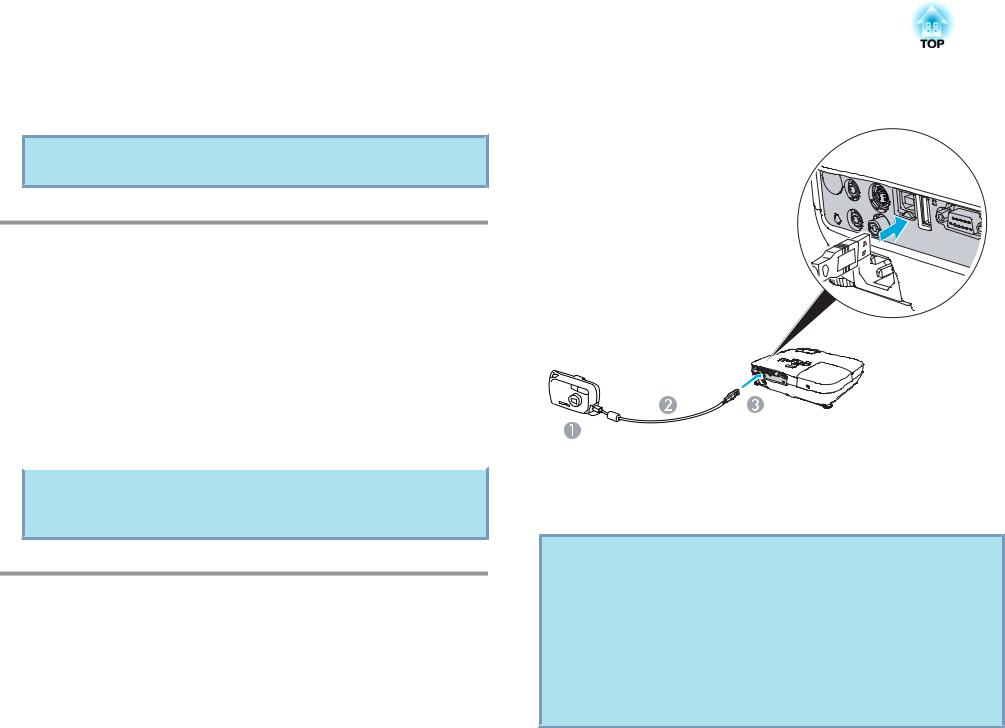
Projecting JPEG Images in a Slideshow |
|
23 |
|
|
|
In Slideshow, you can connect a USB storage device or a digital camera to the projector, and directly project the image files saved on the device.
q It may not be possible to use USB storage devices with security functions.
Specifications of Files that can be Projected in a Slideshow
Type |
|
File Type (ex- |
Remarks |
|
|
|
tension) |
|
|
Still image |
.jpg |
The following cannot be projected. |
|
|
|
|
|
• CMYK color mode format |
|
|
|
|
• Progressive format |
|
|
|
|
• Resolutions exceeding 8176x6144 |
|
|
|
|
• Files with extension ".jpeg" |
|
|
|
|
Due to the characteristics of JPEG files, images with |
|
|
|
|
high compression ratio may not be projected clearly. |
|
|
|
|
|
|
|
|
|
||
q |
• Use media that have been formatted on Windows, as some file |
|
||
|
systems may not |
be supported by the projector. |
|
|
• Format the media to FAT16 or FAT32.
Connecting and Removing USB Devices
Connecting USB devices
Connect the USB device containing the image files to be played back in Slideshow to the projector's USB(TypeA) port. When connecting a digital camera, connect it to the projector using a USB cable provided with, or specified for use with your digital camera.
Example: Connecting a digital camera
ATo digital camera USB port
BUSB cable
CTo USB(Type A) port
Attention
•If you use a USB hub, the Slideshow will not function correctly. Devices such as digital cameras and USB storage devices should be connected to the projector directly.
•When connecting and using a USB-compatible hard disk, make sure you
connect the AC adaptor supplied with the hard disk.
• Connect a digital camera or hard disk to the projector using a USB cable provided with, or specified for use with the device.
•Use a USB cable less than 3 m in length. If the cable exceeds 3 m, Slideshow may not function correctly.

Projecting JPEG Images in a Slideshow |
|
24 |
|
|
|
Removing USB devices
After finishing projecting, remove the USB device from the projector's USB(TypeA) port.
For digital cameras, hard disks, and so on, turn off the power to the device and then remove.
Starting and Ending a Slideshow
Starting a slideshow
Procedure
A Switch the projected image to USB.s p.13
B Connect the USB storage device or the digital camera to the projector.s p.23
The Slideshow starts and displays the file list screen.
Ending a slideshow
Procedure
To end a Slideshow, remove the connected USB device from the projector. s "Removing USB devices" p.24
q |
• You can insert a memory card into a USB card reader and |
|||
connect it |
to the projector. However, it may not be possible to |
|||
|
use some commercially available USB card readers with the |
|||
|
projector. |
|
|
|
|
• If the following screen (Select drive screen) appears, select the |
|||
|
drive |
you |
want |
to use by pressing the [ ][ ] buttons, then |
|
press |
the |
Enter |
button. |
• To display the Select |
drive screen, set the cursor to Select drive |
on the top of the file |
list screen and press the Enter button. |
• Up to four drives can be recognized at one time by the projector.
Slideshow Basic Operations
This section explains the procedure for playing back and projecting images in Slideshow.
Although the following steps are explained based on the Remote Control, you can perform the same operations from the projector's Control panel.
Procedure
A Press the [  ][
][  ][
][ ][
][ ] buttons to set the cursor on the file or folder you want to operate.
] buttons to set the cursor on the file or folder you want to operate.
